Scientific name: Ericameria nauseosa (Pursh) G.L.Nesom & G.I.Baird
Common names: rubber rabbitbrush, gray rabbitbrush, chamisa, chamiso
Family: Asteraceae
By Susan Bruneni
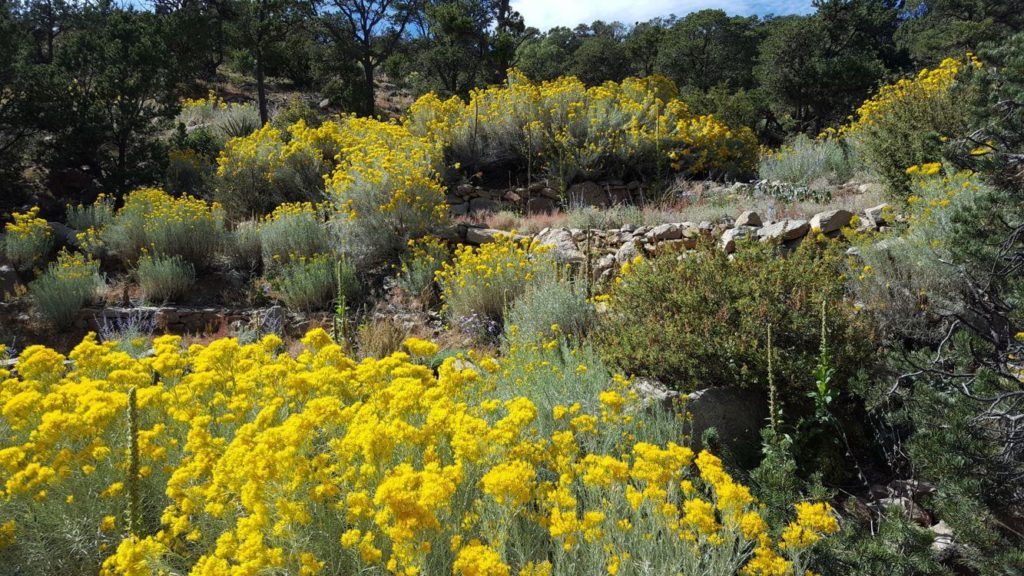
Photo: Joy Mandelbaum
A prominent feature in northern New Mexico landscapes is rubber rabbitbrush, locally known as chamisa. (Note: The common names chamisa or chamiso are used for a variety of desert plants, including unrelated species such as four-wing salt bush, Atriplex canescens). The species was formerly in the genus Chrysothamnus and there is still disagreement over the accepted plant taxonomy. According to the Plants of the World Online, the accepted species name also contains 23 infraspecific varieties. Nine varieties listed below are found in New Mexico and the three that occur at the Leonora Curtin Wetland Preserve are linked (the list below includes the names of the botanists who author the descriptions of the taxa):
- Ericameria nauseosa var. arenaria (L.C.Anderson) G.L.Nesom & G.I.Baird
- Ericameria nauseosa var. bigelovii (A.Gray) G.L.Nesom & G.I.Baird
- Ericameria nauseosa var. graveolens (Nutt.) Reveal & Schuyler
- Ericameria nauseosa var. hololeuca (A.Gray) G.L.Nesom & G.I.Baird
- Ericameria nauseosa var. latisquamea (A.Gray) G.L.Nesom & G.I.Baird
- Ericameria nauseosa var. nitida (L.C.Anderson) G.L.Nesom & G.I.Baird
- Ericameria nauseosa var. oreophila (A.Nelson) G.L.Nesom & G.I.Baird
- Ericameria nauseosa var. turbinata (M.E.Jones) G.L.Nesom & G.I.Baird
- Ericameria nauseosa var. texensis (L.C.Anderson) G.L.Nesom & G.I.Baird
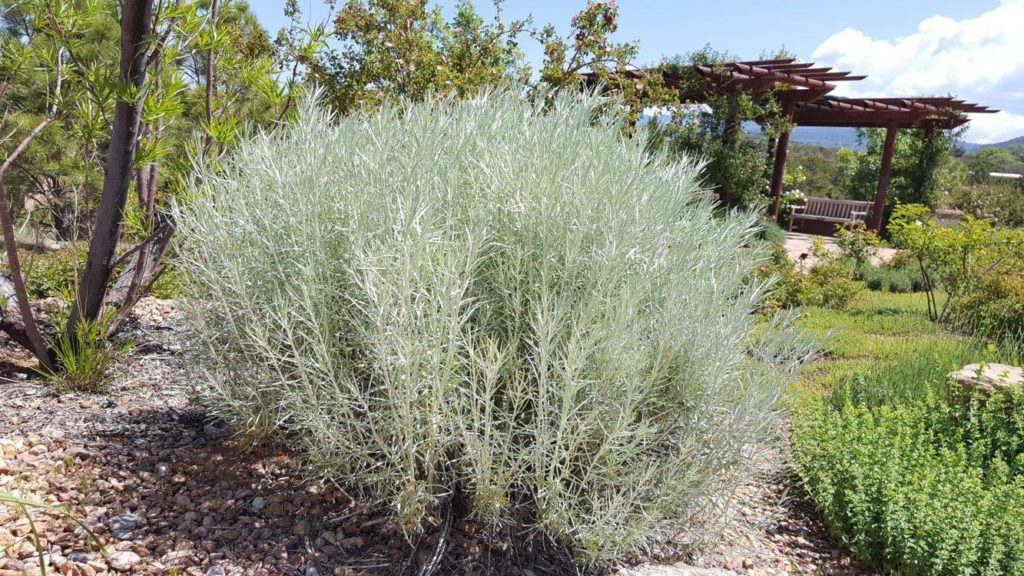
Photo: Joy Mandelbaum
This fast-growing shrub reaches maturity in two to four years with a lifespan of five to 20 years. Flexible stems are whitish to gray, with grayish-green alternate leaves. The roundly shaped shrubs vary in height from two to five feet, but can grow to seven feet. Flower heads are made up of five small, yellow, tubular flowers, and are arranged in dense, rounded or flat-topped clusters at the ends of the branches. Flowers bloom from August to October (depending on rainfall) providing vivid golden color and a pollen source for insects. Flowers dry to a straw color and remain on the plant, extending color into winter.
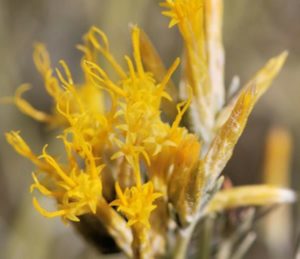
Photo: Janice Tucker
“One common misconception,” says Linda Churchill, head gardener for the Santa Fe Botanical Garden at Museum Hill, “is that chamisa is a primary cause of fall allergies. The blooms are bright yellow and strongly scented, so you notice them. But actually the large, sticky pollen is too big to be transported by air: it’s designed to be borne by insects. The flowers appear at the same time as other plants that produce air-borne pollen such as grasses and chenopods, but it gets the blame.”
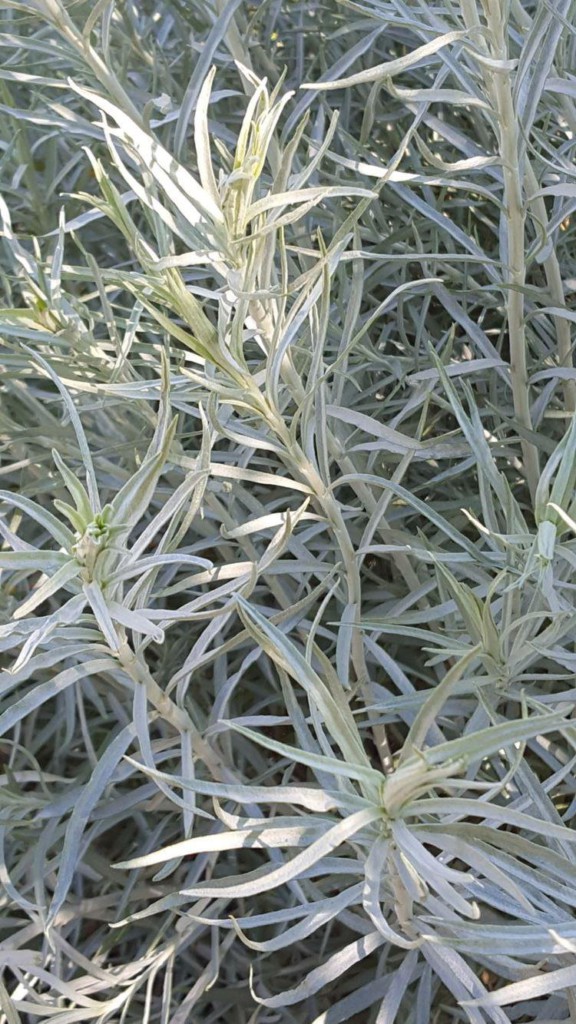
Photo: Joy Mandelbaum
Some of the harshest conditions and landscapes are where rubber rabbitbrush does best. The soils can be poor, alkaline, and coarse, yet the plants will form dense stands, and thrive even on landscapes considered inhospitable such as disturbed, degraded sites, roadsides and rangelands. Although it does help stabilize soil and restore these sites by utilizing its deep root system and establishing quickly, creating a layer of leaf litter, helping to bring nutrients to the soil surface.
Rubber rabbitbrush is also looking more favorable in planted gardens. The white-gray foliage, abundant flowering, and tolerance for poor conditions makes it well suited for desert landscaping. Once established plants need very little water.
Rabbitbrush is available from growers or can be planted from seed. It is possible to transplant once the plant begins to go dormant, but the long tap root makes it more difficult. Plants begin producing seeds when they are two or more years old. Seeds can be harvested in fall or early winter by shaking or stripping the heads from the branches.
Regular pruning will promote health, provide air circulation, and maintain a desirable shape by removing dead or damaged branches. Pruning is best done in late-winter to early spring before new growth appears. Pruning in deep winter can weaken the plant and eventually kill it. The simplest pruning technique is to shear the entire plant back by about one-quarter to one-third its total height, making a rounded shape. “Renewal” pruning occasionally–once every few years or so—can be achieved by cutting back harder, up to one-half or more of the total plant size. Do not do this yearly or you will shorten the plant life span.
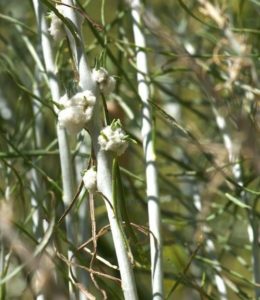
Ericameria nauseosa var. latisquamea with galls (Photo: Janice Tucker)
If galls appear on the chamisa they are harmless and do not need to be removed. They contain the larvae picture-winged fruit fly (Aciurina spp. of the Family Tephritidae of the Order Diptera). They lay their eggs on chamisa and generate a chemical which creates the white round protective galls. When the insect emerges the galls remain on the plant indefinitely.
Native Americans used rabbitbrush to make a yellow dye, for medicinal tea, and for chewing gum. The forage value of rubber rabbitbrush varies greatly among varieties but is beneficial for mule deer, pronghorn, and jackrabbits during fall and winter. It also provides cover for mammals and small nesting birds.
The species name “nauseosa” refers to the smell given off when the leaves or flowers are crushed, described as pineapple-like by some and foul and rubbery by others. The common name refers to the rubber content in the sap, which varies across the taxa. Rabbitbrush was first tested as a source of high quality rubber during World War II. In recent decades, there has been renewed interest in its potential for production of rubber, resins, and other chemicals. Rubber rabbitbrush has also been identified as a potential source of biomass and biocrude fuels and insecticides.
References
“Ericameria nauseosa (rubber rabbitbrush)”. USDA, NRCS. 2019. The PLANTS Database (http://plants.usda.gov , 29 July 2019.) National Plant Data Team, Greensboro, NC 27401-4901 USA.
“Ericameria nauseosa”. Garden Explorer. Santa Fe Botanical Garden. Web. 29 July 2019. Retrieved from: https://santafebotanicalgarden.gardenexplorer.org/taxon-743.aspx
“Ericameria Species, Chamisa, Rubber Rabbitbrush”. Dave’s Garden. Web. 29 July 2019. Retrieved from: https://davesgarden.com/guides/pf/go/65435/#b
Malaby, Sarah. “Rubber Rabbitbrush”. Plant of the Week. U.S. Forest Service. Web. 29 July 2019. Retrieved from: https://www.fs.fed.us/wildflowers/plant-of-the-week/ericameria_nauseosa.shtml
Whiting, D., Cox, R., O’Meara, C., and Wilson, C. “Pruning Flowering Shrubs.” Colorado State University Extension Master Gardener CMG GardenNotes #616. 2018 May. Web. 29 July 2019. Retrieved from: http://cmg.colostate.edu/Gardennotes/616.pdf
“Rubber rabbitbrush”. Great Basin Seed. Web. 29 July 2019. Retrieved from: https://greatbasinseeds.com/product/rubber-rabbitbrush/


